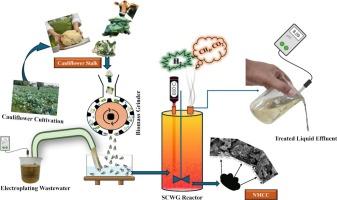电镀锌金属废水水热降解生物质制氢研究。
IF 7.1
2区 环境科学与生态学
Q1 ENGINEERING, ENVIRONMENTAL
引用次数: 0
摘要
超临界水气化(SCWG)是一项不断发展的技术,它直接将复杂的湿式有机废物转化为富氢燃料气体,同时从废水中回收重金属。在这项研究中,在印度广泛使用的木质纤维素原料,如花椰菜茎,与电镀工业的重金属污染废水一起用于制氢。重点研究了停留时间对气、液、固相产物分布的影响。在600℃温度和50 min停留时间下,总产气率最高(TGY)为31.7 mol/kg, H2产率最高(26.2 mol/kg)。采用总有机碳(TOC)和微波等离子体原子电子能谱(MP-AES)分析处理液中有机碳和金属的浓度。FE-SEM, XRD和XPS分析证实了超临界水气化过程中废水中重金属的固定化生成纳米碳复合材料。在600℃、停留时间为60 min的条件下,获得了最大比表面积(73.43 m2/g)和孔体积(0.12 cc/g)。本文章由计算机程序翻译,如有差异,请以英文原文为准。

Hydrothermal degradation of biomass with Zn electroplating metal effluent for H2 production
Supercritical water gasification (SCWG) is an evolving technology that directly converts complex wet organic waste into hydrogen-rich fuel gases while simultaneously recovering heavy metals from the wastewater. In this study, lignocellulosic feedstock like cauliflower stalk, which is widely available in India, was used along with the heavy metal-contaminated wastewater from electroplating industries for hydrogen production. The research highlights the impact of residence time on the product distribution of gas, liquid, and solid phases. At 600 °C temperature and a 50 min residence time, the highest total gas yield (TGY) (31.7 mol/kg) and the maximum H2 yield (26.2 mol/kg) were obtained. The treated liquid was analyzed using total organic carbon (TOC) and Microwave Plasma Atomic Electron Spectroscopy (MP-AES) analysis to measure organic carbon and metal concentration. FE-SEM, XRD, and XPS analysis confirm the immobilization of the heavy metals from wastewater to produce nanometal carbon composite during the supercritical water gasification process. The maximum specific surface area (73.43 m2/g) and the pore volume (0.12 cc/g) was obtained at 600 ℃, and the residence time was 60 min.
求助全文
通过发布文献求助,成功后即可免费获取论文全文。
去求助
来源期刊

Waste management
环境科学-工程:环境
CiteScore
15.60
自引率
6.20%
发文量
492
审稿时长
39 days
期刊介绍:
Waste Management is devoted to the presentation and discussion of information on solid wastes,it covers the entire lifecycle of solid. wastes.
Scope:
Addresses solid wastes in both industrialized and economically developing countries
Covers various types of solid wastes, including:
Municipal (e.g., residential, institutional, commercial, light industrial)
Agricultural
Special (e.g., C and D, healthcare, household hazardous wastes, sewage sludge)
 求助内容:
求助内容: 应助结果提醒方式:
应助结果提醒方式:


